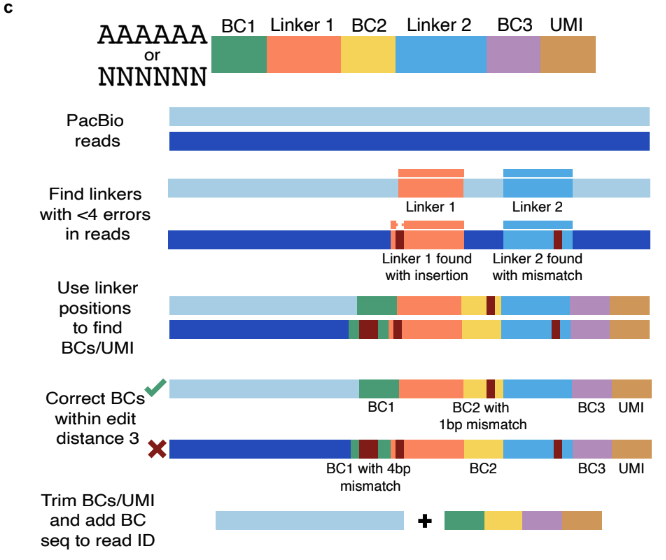LR-splitpipe is a pipeline designed for demultiplexing, debarcoding, and preparing LR-Split-seq data.
To demultiplex reads for their Split-seq barcodes, use demultiplex.py.
Usage: python LR-splitpipe/demultiplex.py {all, score_linkers, find_bcs, process_bcs} [options]
Subcommands:
all Run all steps of demultiplexing
score_linkers Run steps through scoring the linkers (step 1)
and generate QC plots based on scored linkers
find_bcs Run all steps through finding the barcodes (steps 1-3)
process_bcs Run steps after finding barcodes (steps 4-6)
Options:
-f FASTQ (gzipped or not) file output with LR-Split-seq or Split-seq reads
-o Output file path / prefix
-t Number of threads to run on (multithreading is recommended)
-k Kit used for barcoding {WT, WT_mini, WT_mega}
--l1_mm Number of allowable mismatches in linker1
Default: 3
--l2_mm Number of allowable mismatches in linker2
Default: 3
--chunksize Number of lines to read in / process at a time
Default: 10**5
--max_linker_dist Maximum distance that a linker can be from the end of a read
Default: None (recommended ~200 based on our data)
--max_read_len Maximum read length to analyze for linkers / barcodes
Default: None
--verbosity Verbosity setting.
0: No output
1: QC statistics
2: QC statistics + progress
--delete_input Flag to delete temporary files (recommended!)
First, LR-splitpipe uses alignment to find reads that have linkers in them, which are the static regions that connect each of the combinatorial barcodes. Reads that have fewer than 4 errors in each linker will then be used to find barcodes.
Using the reads that had valid linkers found in them, determine the location in the read of each linker. Note: This step typically takes the longest! Parallelization will help with this!
With the locations of the linkers from step 2, extract the barcodes from each read.
Correct barcodes to those that are within edit distance of 3 of the list of possible Split-seq barcodes. This step uses code and assets (barcodes and barcodes within edit distance 3) from the original Parse Biosciences Split-seq demultiplexing code, which is designed for short reads.
After recording the barcode and UMI for each read, trim the construct off from the sequence as this part will mess up mapping.
Filter out reads with duplicate UMIs per barcode, keeping the longest read.
Take the barcode/UMI for each read and append it to the read name of each read. Output the trimmed reads labeled by their barcodes to a fastq file.
After running the demultiplexer, reads should be mapped and converted to a SAM file. In this file format, the barcode, which is in the read header in fastq format, can be moved to a cell barcode (CB:Z:NNNNN...) tag as part of the SAM file. This is useful to be able to run TALON on the single-cell data down the line. To do this, run add_bam_tag.py.
Note: It is recommended to use the --merge_primers option. If you don't use this option, oligodT primed and random hexamer primed reads from the same cells won't be merged
Usage: python LR-splitpipe/add_bam_tag.py
Options:
-s SAM file with Split-seq barcode+UMI information in
the read name
-k Kit used for barcoding {WT, WT_mini, WT_mega}
--merge_primers Merge reads that come from the same cell from different
priming strategies
--suffix Suffix to add to cell barcodes. Useful if merging
separate LR-Split-seq experiments that might have
overlapping barcodes otherwise
-o Output file path/prefix
Please cite our publication and / or the Zenodo DOI for the release you used!
